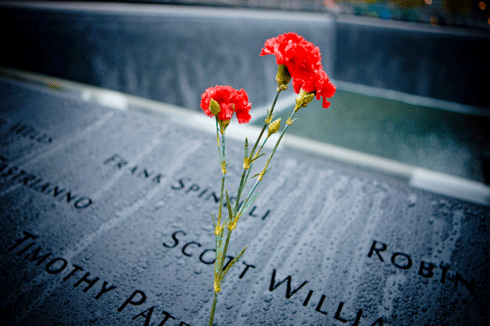
|
Published: 2 April 2013
Designing for hope
Hope is often in short supply after disaster strikes. Jenny Donovan specialises in urban design in difficult circumstances such as after disasters and conflicts. She believes her profession has a key role to play in creating physical environments where hope can flourish again. Here she talks to Michele Sabto about her new book Designing to Heal.

|
|
Part of the water garden at the former World Trade Centre site in New York – a place designed for both public use and quiet contemplation. Credit:
Anna Bryukhanova/istockphoto
|
In Designing to Heal, high-quality shared space is seen as a key facilitator for reconciliation in post-conflict situations. What is the significance of shared space in these situations?
Reconciliation can happen anywhere, not just spaces built for that purpose. If people in their day-to-day life can share space with people and see that ‘the enemy’ isn’t the enemy but is someone like them with children to be looked after and everyday concerns to worry about, then this goes a long way to humanising the opposing community. It becomes more difficult to demonise a community and motivate people to hate and to build up conflict.
One example I give in the book is the provision of shared sport facilities where, in a sense, the conflict can be at least in part displaced onto competition.
Your discussion of the urban design response to the World Trade Centre site after the 9/11 disaster illuminates some of the issues around spaces that aim to memorialise past events. You quote Craig Dyker, one of the architects who worked on the design of the memorial now on the site, who has said ‘If you want to memorialise something, don’t just build a memorial’. What does he mean?
I thought that was a very powerful statement. He said that sometimes memorials trip people up on the road to recovery. They keep people at a point where the trauma is real and where it is still an open wound. If, as some people wanted, the 9/11 site had been left as a hole in the ground it would speak of destructiveness and the pain that people had suffered there. It would have spoken very eloquently about it and would have therefore been an articulate memorial, but it would have done little to help the survivors move on.
As it is, the memorial water garden now on-site invites a range of experiences. You can visit and engage in quiet contemplation and grieving, but if you just want to go there on a lunch break and enjoy it, you can (particularly around the periphery) and you can be perfectly proud of what your city has achieved as an urban space. This wouldn’t be possible with more stereotypical memorials. For example, it would be rude, to sit on some of Australia’s war memorials and have your lunch or for children to play.
As buildings and spaces age and lose condition, the way they are used changes. You write of this unplanned change in terms of the development of ‘marginal but diverse places’ that support businesses such as art galleries, bars and cafes that would otherwise be unable to afford the inner city rents. How do these uses fare in post-disaster rebuilds?
I can think of examples where places have been rebuilt in a homogenous way that alienates small local businesses. But there are contrasting examples, like what is happening in Christchurch at the moment. They’ve done some brilliant stuff there with transitional and temporary use of space – the art of what you can do with a shipping container has been taken to new heights – with groovy bars, cafes and workshops for artisans. These incidental, cheap uses are thriving there because of an enlightened approach to the rebuilding process. Time will tell if the market can sustain this.
Can you think of post-disaster rebuilds that have met broader aims not directly associated with the disaster?
In London the ‘ring of steel’ barriers put up to keep the IRA car bombs out of the city have been retained in places because city dwellers and workers found they liked the city without so much traffic. The steel and concrete barriers have often given way to little pocket parks on footpaths that give people somewhere to sit, rest and take in the world.
Much of Designing to Heal is devoted to the psychology of disaster survival, tracking the changing psychological responses of survivors over time. How does this understanding relate to your advocacy of small-scale, easily achievable collaborative projects that are often transitional or temporary?
Places matter to people. If you’ve lost your community, you suddenly become rootless. The people you lived alongside might be changed by the disaster or gone, displaced or dead. Your previous neighbourhood or city is likely to have gained many sad memories and negative associations.
Under these circumstances it is very difficult to learn to reconnect with a place again and feel that it is home, it is yours. People who have survived disasters talk of being afraid to hope, of being afraid of investing emotionally in rebuilding. For many, it is much easier to give up and not try, overwhelmed by loss and a fear of losing again.
Small-scale, quickly achieved, temporary projects that are collaborative can show survivors that progress is possible and that it is possible to re-establish emotional connections to your surroundings. It can reveal the light at the end of the tunnel and show that the light isn’t an oncoming train.
In Christchurch after the earthquake two volunteer organisations ‘Greening the Rubble’ and ‘Gap Filler’ have worked with CERA, the government reconstruction authority. They take places that have been cleared and establish temporary installations, often designed by professional designers who volunteer their time. One is on the edge of the city centre on a cleared site that used to have a commercial use. A little double-door commercial fridge on the site is stocked with, not food, but books, and there are seats around the edges of the site, with some paving and gravel. It is a library garden. Another installation is a relocatable cycle-powered open-air cinema.
These are small feel-good installations that come and go, and constantly surprise and delight people. The setup is done by residents who are also in a sense survivors and for whom it is important to be part of the renewal process. For many, it is a way to keep busy and helps them realise they can set and meet challenges, giving them some control over their surroundings and a sense of achievement.
One of the steps you advocate in the recovery and renewal process is to ‘map the social landscape of the community’. What do you mean by this?
There are probably parts of where you live that mean a lot to you. And people in your neighbourhood may share this sense that the same places are important and meaningful.
You might, for example, say that a particular park is a place that you really like to use but it has some concerns for you. So mapping the social landscape is about mapping places in terms of their significance for people – good and bad: ‘I’m worried about here because of...’, ‘I like here because of...’. Of course there isn’t just one social landscape for a community but there are often recurring patterns of significance that can be telling.
These let the designer build a sense of where is important to people and for what reason. This can guide decisions to concentrate design efforts in those locations because that will ensure that the design reflects the design priorities and sensitivities revealed by social landscape help people feel they have been heard.
The social landscape is every bit as important as the physical landscape. We talk a lot about design to accommodate trees, and hills and topography and this thing we call ‘aesthetics’ and rightly so but by trying to understand the social landscape we can add another layer to this, a layer informed by the cognitive processes of the people that experience that place and whose lives will be affected by our work.
What makes this book timely?
With resource depletion and climate change we are looking at increased frequency of drought and floods and bushfires and probably a diminished ability to rely on ‘big’ outside agencies to come and help. In Australia population growth and tree and sea-changers are putting significant development pressure on land. Elsewhere competition for increasingly scarce resources such as water, oil and productive land may turn into conflict.
At the end of the day, cities are static and vulnerable things. They are getting bigger and there are more of them. Events that never previously caused disasters because they occurred in places that were uninhabited or areas that could easily be evacuated will increasingly result in tragedy and disruption.
Cities are the hubs of longer and longer chains of services and specialists on which we all depend in order to meet our needs. They are the settings of cherished memories and important experiences.
Designing to Heal is intended to be a pair of spectacles through which people can look at these issues and the subsequent rebuilding process; it poses questions that I hope people will find helpful in the task of ensuring that resources invested rebuilding achieve the best outcome.



